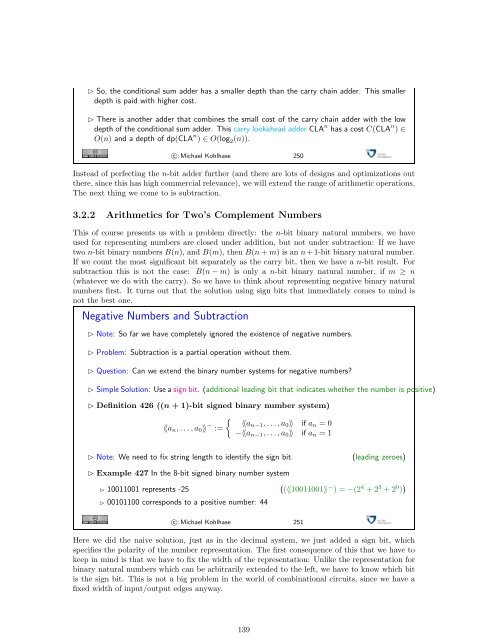General Computer Science 320201 GenCS I & II Lecture ... - Kwarc
General Computer Science 320201 GenCS I & II Lecture ... - Kwarc
General Computer Science 320201 GenCS I & II Lecture ... - Kwarc
You also want an ePaper? Increase the reach of your titles
YUMPU automatically turns print PDFs into web optimized ePapers that Google loves.
So, the conditional sum adder has a smaller depth than the carry chain adder. This smaller<br />
depth is paid with higher cost.<br />
There is another adder that combines the small cost of the carry chain adder with the low<br />
depth of the conditional sum adder. This carry lookahead adder CLA n has a cost C(CLA n ) ∈<br />
O(n) and a depth of dp(CLA n ) ∈ O(log 2(n)).<br />
c○: Michael Kohlhase 250<br />
Instead of perfecting the n-bit adder further (and there are lots of designs and optimizations out<br />
there, since this has high commercial relevance), we will extend the range of arithmetic operations.<br />
The next thing we come to is subtraction.<br />
3.2.2 Arithmetics for Two’s Complement Numbers<br />
This of course presents us with a problem directly: the n-bit binary natural numbers, we have<br />
used for representing numbers are closed under addition, but not under subtraction: If we have<br />
two n-bit binary numbers B(n), and B(m), then B(n + m) is an n + 1-bit binary natural number.<br />
If we count the most significant bit separately as the carry bit, then we have a n-bit result. For<br />
subtraction this is not the case: B(n − m) is only a n-bit binary natural number, if m ≥ n<br />
(whatever we do with the carry). So we have to think about representing negative binary natural<br />
numbers first. It turns out that the solution using sign bits that immediately comes to mind is<br />
not the best one.<br />
Negative Numbers and Subtraction<br />
Note: So far we have completely ignored the existence of negative numbers.<br />
Problem: Subtraction is a partial operation without them.<br />
Question: Can we extend the binary number systems for negative numbers?<br />
Simple Solution: Use a sign bit. (additional leading bit that indicates whether the number is positive)<br />
Definition 426 ((n + 1)-bit signed binary number system)<br />
〈〈an, . . . , a0〉〉 − <br />
:=<br />
〈〈an−1, . . . , a0〉〉<br />
−〈〈an−1, . . . , a0〉〉<br />
if an = 0<br />
if an = 1<br />
Note: We need to fix string length to identify the sign bit. (leading zeroes)<br />
Example 427 In the 8-bit signed binary number system<br />
10011001 represents -25 ((〈〈10011001〉〉 − ) = −(2 4 + 2 3 + 2 0 ))<br />
00101100 corresponds to a positive number: 44<br />
c○: Michael Kohlhase 251<br />
Here we did the naive solution, just as in the decimal system, we just added a sign bit, which<br />
specifies the polarity of the number representation. The first consequence of this that we have to<br />
keep in mind is that we have to fix the width of the representation: Unlike the representation for<br />
binary natural numbers which can be arbitrarily extended to the left, we have to know which bit<br />
is the sign bit. This is not a big problem in the world of combinational circuits, since we have a<br />
fixed width of input/output edges anyway.<br />
139
















